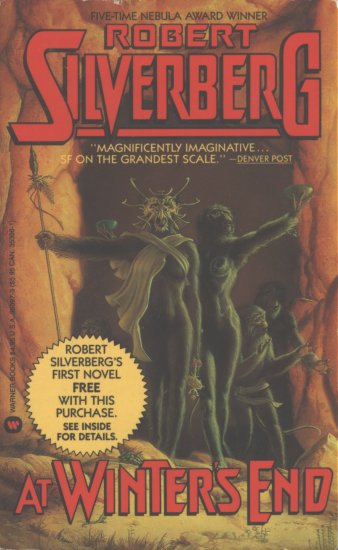At Winter's End
- Form
- Novel
- Year
- 1988
Publication history
- 1988: At Winter's End, Warner Mass market paperback, 404 pp.
- 1988: At Winter's End, Warner Hard cover book, 404 pp.
- 1988: At Winter's End, Gollancz Hard cover book
- 1988: At Winter's End, Science Fiction Book Club Hard cover book
- 1988: At Winter's End, Mass market paperback, in Hebrew
- 1989: À la fin de l'hiver, Laffont Hard cover book, 417 pp., in French as À la fin de l'hiver
- 1989: Am Ende des Winters, Lübbe Mass market paperback, 668 pp., in German as Am Ende des Winters
- 1990: Al Final de Invierno, Ediciones B Mass market paperback, in Spanish
- 1990: At Winter's End, Legend Trade paperback, 491 pp.
- 1990: At Winter's End, Legend Mass market paperback, 491 pp.
- 1996: À la fin de l'hiver, Livre de Poche Mass market paperback, 569 pp., in French as À la fin de l'hiver
- 2000: Fictionwise, Fictionwise On-line
Blurb
(From Warner 1988)For 700,000 years the falling death-stars have locked the Earth in an endless winter of sorrows. For 47,000 generations Koshmar's tiny tribe has survived beneath the ice. Now prophecies proclaim the time has come to emerge and inherit the lost ruins of a new world.
A world where ancient enemies are real, but ancient gods have no power. Where a child knows more than the wisest elder. Where every step brings fresh wonder and feverish terror. Where prophecies lead to the fabled city of the Great World. And where Koshmar's people, primitives amid the ruins of an interstellar civilization, will find their foretold destiny. But other tribes — some not human — are also emerging into the New Springtime. With other prophecies of their own...
Comments
This is a far-future story set on Earth, hundreds of thousands of years in the future,
when the earth is coming out of a long Ice Age induced by death-stars.
The planet has been populated by numerous intelligent species descended from insects and
plants as well as humanoids; but actual humans are nowhere to be seen, departed for
the stars long ago. The story continues in The Queen of
Springtime. There was a third book planned, but never written.
You only have to look at the Michael Whelan's lovely cover art from the
original US paperback to see that the cover blurb is misleading:
Koshmar and her people are not human, at least not Homo sapiens, though in the book
the characters sometimes refer to themselves as human
. As the story progesses, some of
them discover of the older meaning of that word.
The people of Koshmar's tribe have adopted some very interesting (and practical)
strategies to survive long millennia in the confinement of caves. For one thing,
breeding is strictly regulated, with only certain individuals allowed to produce
young. Non-breeders seem to be favor same-sex relationships, like that of Koshmar and her
twining-partner
Torlyri, both female, though heterosexual coupling
is common. They seem to have some unspecified method of birth control. Life-spans are limited to
thirty-five years, after which individuals depart from beyond the hatch, presumably
to die in the harsh outside world; their bones litter the hillside below the hatch.
The chronicaller, or tribe historian, is the only exception, as thirty-five years
would not be long enough to learn all the tribe's history.
Quite an enjoyable book, and my sister's all-time favorite Silverberg novel.
Other resources
(None on file)
